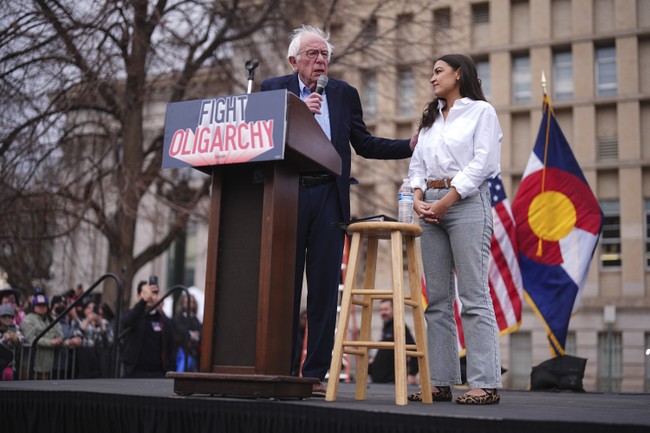
The Democratic Party is effectively decapitated, which means that it is every man and Xe for they/them.
As America has become increasingly divided, what motivates liberal voters, and especially the increasingly radical base of the Democratic Party, are fringe issues that are either irrelevant or even offensive to everybody else.
What that means is that Democrats from safer Blue districts have an incentive to push the ideological boundaries, while Democrats from swing districts are helpless to stop the drift leftward that is endangering their electoral prospects. The only reason why Democrats still have a shot at gaining a majority in the House of Representatives is that gerrymandering ensures that there are very few actually competitive congressional districts.
New York @GovKathyHochul (D) announces New York taxpayers will be footing the bill for $50M in legal services for illegal immigrants in the state. pic.twitter.com/gnTxunbI0J
— Fox News (@FoxNews) June 18, 2025
If you wonder why the Democrats gravitate to every 20 side of 80-20 districts, it’s the incentive to pander to their leftist base. The ideological energy is concentrated in the AOC/David Hogg/Randi Weingarten wing of the party, while the older donor and business base of the party would prefer to stay away from the fringy issues. The Democrat establishment kicked Hogg and Weingarten out of power, but then again, their power has nothing to do with the institution itself.
Just when you thought the current state of the Democratic Party couldn’t get any worse…
Reports say the DNC is out of money, and top officials are now talking about taking out loans to cover the bills.
Brutal. pic.twitter.com/yWXqPQdMQy
— Benny Johnson (@bennyjohnson) June 18, 2025
The big billionaire donors are on the left, while the old donor base has until now stuck with the Democrats to buy favors and get contracts. They sense the winds changing and may pull back on their support. The DNC dumping the radicals is a fundraising move, and a smart one at that, but it also alienates many on the left who identify more with the radical ideologies than with an institution.
Just months into the tenure of a new party leader, Ken Martin, the Democratic National Committee’s financial situation has grown so bleak that top officials have discussed whether they might need to borrow money this year to keep paying the bills.
Fund-raising from major donors — some of whom Mr. Martin has still not spoken with — has slowed sharply. At the same time, he has expanded the party’s financial commitments to every state, and even to far-flung territories like Guam.
Fellow Democrats are grumbling that Mr. Martin, who quietly accepted a raise after taking the post, has been badly distracted by internal battles. So far, they say, he has been unable to help unite his party against Republicans, who control the federal government.
The dilemma is readily apparent in Gavin Newsom’s not-so-secret bid to become the Democratic nominee for president. He launched his shadow campaign with the introduction of a podcast, rolling out one conservative after another for conversations intended to make Newsom look moderate.
🚨Democrat Rep. Maxwell Frost says he wants amnesty for every single illegal alien in America: “Let’s document EVERY single one of them with a speedy path to citizenship.” pic.twitter.com/chgTnxhTuY
— TheBlaze (@theblaze) June 18, 2025
That ended quickly. Newsom took a lot of flak from his left, and now he is campaigning on keeping as many Tren de Aragua gang bangers as possible in the country.
Illegal immigration and restricting transgender participation in girls’ sports are two of the hottest issues for the Democratic base, and both repel the majority of the country. But any deviation from the lefty line is harshly punished, so the incentive to emphasize opposition to the mainstream is very high.
After all, in Blue districts, the moderate and Republicans are electorally irrelevant.
All this means that Democrats are going to be frozen out as a national party, even though they can remain very relevant in individual districts and may be able to cobble together temporary majorities in the House. When Republicans screw up or economic conditions are unfavorable, Democrats may be able to squeak into temporary majorities, but driving a national agenda will be very difficult for them.
The Atlantic’s newsletter, which is about as left-friendly as a “mainstream” outlet can be, summed up the problem:
This past weekend marked a high for opposition to Donald Trump, and another low for the opposition party.
From Chula Vista, California, to Portland, Maine, and from Bellingham, Washington, to Key Largo, Florida, Americans demonstrated against the president, in “No Kings” protests scheduled to coincide with Trump’s military parade in Washington, D.C., on Saturday. The parade, desultory and poorly attended, set a striking contrast with the marchers, whom observers estimated to number in the millions. That would make Saturday’s protests some of the largest in American history. Three of the biggest sets of U.S. demonstrations have taken place while Trump has been president, an indication of intense grassroots opposition toward him and his vision for the Republican Party.
So these ought to be boom times for America’s other major party. But Democrats seemed almost entirely irrelevant last weekend. While many ordinary Americans engaged in the most kinetic kind of politics, the Democratic National Committee was splintering acrimoniously, and some of the party’s most prominent leaders were busy attending a glitzy Hamptons wedding that brought together two venerable, aging dynasties: the Soros family and the Clinton political machine. Although Democratic officials attended and spoke at many of Saturday’s rallies, the No Kings protests were not driven by the Democratic Party—which may have been one of the protests’ strengths.
Not every Democratic politician is missing in action. California Governor Gavin Newsom, who spent recent months clumsily attempting to moderate his image by inviting MAGA figures on his podcast, now finds himself as the nation’s foremost Trump foil. Minnesota Governor Tim Walz won praise for his handling of the response to the assassination of one state legislator and the wounding of another this past weekend. Senator Bernie Sanders of Vermont and Representative Alexandria Ocasio-Cortez of New York have drawn huge crowds at rallies around the country.
Swing elections are not driven by ideology as much as conditions. Sometimes parties win not because people like them, but because they despise the other side and want to punish them. This is also why Democrats are betting everything on attacking Trump, even though that has been a weak strategy for them. Opposition to Trump is the one uniting principle for an increasingly fractured party.
Don’t expect the Democrats to moderate any time soon. The incentives are just too strong for individual politicians to make the obvious move to the center attractive for any Democrats in Blue districts. No doubt, many privately worry that the base of the party has gone too far, but they feel powerless to stop the movement.
It’s a dilemma. Damned if they do, damned if they don’t.








